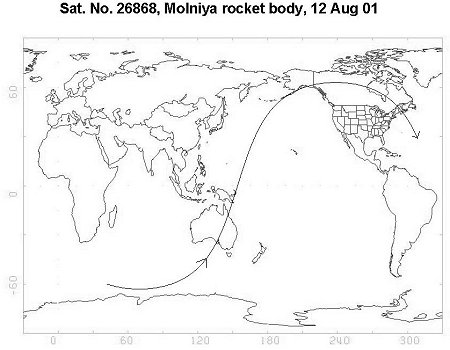|
What follows is a communication from Dr. Peter Brown, Los Alamos National Laboratory, regarding the re-entry of a Molniya rocket body on August 12, 2001: "[Pictured below] is a ground-track plot of the final pass of the rocket body, launched July 20 and designated object 26868 by US SPACECOM. The launch was of Molniya-3 from Plesetek and consisted of a communications satellite. The object which actually burned-up over Quebec and New Brunswick was the upper-stage rocket body associated with the Molniya-M booster used to lift the communications satellite."  "The initial predictions from US SPACECOM were for it to have re-entered much earlier in its orbit over the Indian Ocean. As is often the case for such a large object, the predictions are heavily dependent on modelling the exact drag for such an object and this is difficult. The end result is that the object went an additional 1/2 orbit before actually burning up. "Note that the rocket body was large enough that some debris likely made it to the ground. Had this occurred over land in Canada, it could have been problematic in terms of damage, though the amount reaching the ground might have been relatively small. Interestingly, though lots of rocket body re-entries have occurred very few have ever had recovered debris, so the amount making it to the ground for a given booster is largely unknown. According to information I have the final decay occurred 12 August, 03:38 UTC +/- 07 minutes (36.9°N, 302.9°E) as the object moved South over the Atlantic. "I hope this helps everyone being asked information concerning this event. For general interest a reentry generating what used to be known as a TIPS (Tracking Impact and Prediction Service) message from US SPACECOM occurs about 1-2 times per week for a minimum cross- sectional area of 1 m2 debris." |